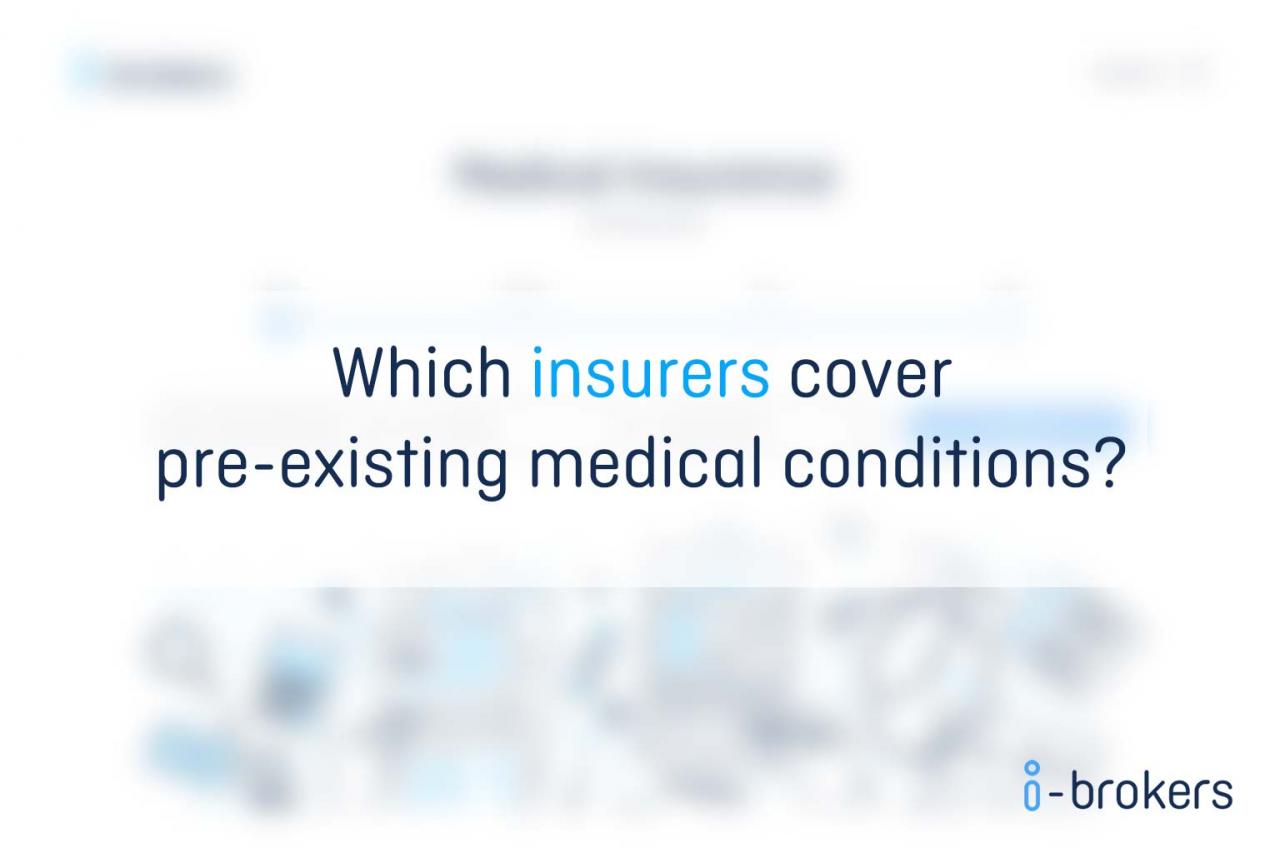Can I get life insurance if I have a pre existing medical condition – Can I get life insurance if I have a pre-existing medical condition? This question plagues many, especially those managing chronic illnesses or past health issues. Securing life insurance with pre-existing conditions isn’t impossible, but it does involve navigating a complex landscape of underwriting processes and policy options. Understanding how insurance companies assess risk, the various policy types available, and strategies for finding affordable coverage are crucial steps in this journey.
This article will unpack the intricacies of life insurance and pre-existing conditions, guiding you through the process of securing coverage even with a health history. We’ll explore different policy types, factors influencing approval, and strategies to improve your chances of getting approved and securing a policy that fits your needs and budget. We’ll also delve into alternative insurance options for those facing significant health challenges.
Understanding Pre-Existing Conditions and Life Insurance

Securing life insurance with a pre-existing medical condition can feel daunting, but understanding the process can empower you to navigate it effectively. This section clarifies the definition of pre-existing conditions, provides examples, explains how insurers assess risk, and illustrates the potential impact on your premiums.
Pre-Existing Medical Conditions Defined
A pre-existing medical condition, in the context of life insurance, refers to any health issue you had before applying for a policy. This includes diagnosed illnesses, ongoing treatments, and even past medical events that might indicate a higher risk of future health problems. It’s crucial to remember that the definition can vary slightly between insurance providers, so transparency with your insurer is key.
Examples of Pre-Existing Conditions
Many conditions can be considered pre-existing. Common examples include: high blood pressure (hypertension), high cholesterol (hyperlipidemia), diabetes, heart disease, cancer (past or current), asthma, chronic obstructive pulmonary disease (COPD), and mental health conditions such as depression or anxiety. The severity and management of these conditions significantly impact the insurer’s assessment.
Assessing Risk Associated with Pre-Existing Conditions
Insurance companies employ several methods to evaluate the risk associated with pre-existing conditions. These include reviewing your medical history (obtained through medical records releases), conducting medical examinations (potentially including blood tests), and requiring you to complete detailed health questionnaires. They analyze the severity, stability, and prognosis of your condition to determine the appropriate level of risk and premium.
Factors like current treatment effectiveness and lifestyle choices also play a role.
Securing life insurance with pre-existing conditions can feel tricky, but it’s definitely possible. Understanding your options often involves careful consideration of different policy features and premiums. To help navigate this, learning how to effectively compare different health insurance plans is key; check out this helpful guide on how to compare different health insurance plans for families for a better understanding.
This knowledge will empower you to make informed decisions about both your health and life insurance needs, even with pre-existing conditions.
Impact of Pre-Existing Conditions on Life Insurance Premiums
The impact of a pre-existing condition on your life insurance premium varies greatly depending on several factors. The table below offers a general comparison; individual cases can differ significantly based on the specifics of the condition, your age, the type of policy, and the insurer.
| Pre-Existing Condition | Potential Premium Impact | Factors Influencing Impact | Possible Mitigation Strategies |
|---|---|---|---|
| High Blood Pressure (well-managed) | Slight increase | Medication adherence, blood pressure levels | Demonstrate excellent health management |
| Type 2 Diabetes (well-controlled) | Moderate increase | HbA1c levels, medication compliance | Provide evidence of effective blood sugar control |
| History of Cancer (in remission for 5+ years) | Significant increase or denial | Type of cancer, remission duration, recurrence risk | Provide comprehensive medical records and specialist opinions |
| Heart Disease (undergoing treatment) | Significant increase or denial | Severity of disease, treatment success | Demonstrate adherence to treatment plans and positive outcomes |
Types of Life Insurance Policies and Pre-Existing Conditions: Can I Get Life Insurance If I Have A Pre Existing Medical Condition

Navigating the world of life insurance with a pre-existing medical condition can feel overwhelming. Understanding how different policy types handle these conditions is crucial for making an informed decision. This section clarifies the key differences between term life and whole life insurance, focusing on how pre-existing conditions impact your application and premiums.The impact of pre-existing conditions varies significantly depending on the type of life insurance policy you’re seeking.
Underwriting processes, which assess risk, differ substantially between term and whole life insurance, leading to varied outcomes for individuals with pre-existing health issues.
Term Life Insurance and Pre-Existing Conditions
Term life insurance provides coverage for a specific period (term), typically ranging from 10 to 30 years. Underwriting for term life insurance is generally more straightforward than for whole life, but pre-existing conditions still play a role. Insurers will review your medical history, and depending on the severity and type of condition, you might face higher premiums, a declined application, or be offered coverage with exclusions.
For example, someone with a history of heart disease might receive a higher premium than a healthy applicant of the same age and gender, or might even be denied coverage altogether depending on the severity and the insurer’s risk assessment. A less severe condition, like well-managed asthma, might result in only a slight premium increase or no impact at all.
Whole Life Insurance and Pre-Existing Conditions
Whole life insurance offers lifelong coverage, building cash value over time. The underwriting process for whole life is typically more rigorous than for term life. Insurers conduct a thorough review of medical records and may require additional medical exams. Pre-existing conditions can significantly influence the approval process and the cost of the policy. A serious pre-existing condition could lead to a higher premium, limitations on coverage, or even rejection of the application.
For instance, someone with a history of cancer might find it challenging to secure whole life insurance, or if approved, face extremely high premiums reflecting the increased risk. However, a less severe condition, like well-controlled diabetes, might only result in a moderately higher premium or require additional medical testing.
Underwriting Processes: Term vs. Whole Life
The underwriting process differs substantially between term and whole life insurance. Term life insurance typically involves a shorter application process, often requiring only a health questionnaire. Whole life insurance, however, usually involves a more extensive process, including medical exams, blood tests, and detailed medical history reviews. This difference in scrutiny directly impacts how pre-existing conditions are evaluated.
A minor pre-existing condition might be easily accommodated in term life insurance, while the same condition could lead to significant premium increases or policy denial in whole life insurance.
Impact of Pre-Existing Conditions: Examples
Consider two individuals applying for life insurance: Person A has well-managed hypertension, and Person B has a history of heart failure. Person A applying for term life insurance might experience a small premium increase, or no increase at all. However, applying for whole life insurance, the same hypertension might lead to a more significant premium increase or require additional medical evaluations.
Person B, with a history of heart failure, is much more likely to face higher premiums or even denial for both term and whole life insurance, due to the significantly higher risk associated with that condition.
Riders and Add-ons for Pre-Existing Conditions
While not directly addressing pre-existing conditions, some life insurance policies offer riders or add-ons that can provide additional benefits or address specific needs. These riders are not designed to specifically cover pre-existing conditions, but they can offer supplementary protection that might be beneficial in certain circumstances. For example, a critical illness rider could provide a lump-sum payment if the policyholder is diagnosed with a serious illness, regardless of whether it was a pre-existing condition.
It’s crucial to discuss these options with an insurance agent to determine their relevance to your specific situation.
Factors Influencing Insurance Approval with Pre-Existing Conditions
Securing life insurance with a pre-existing condition isn’t just about the condition itself. Several other factors significantly influence an insurer’s decision, impacting your eligibility and premiums. Understanding these factors empowers you to navigate the process more effectively.Getting approved for life insurance with a pre-existing condition involves a complex evaluation. Insurers assess your overall health profile, considering elements beyond the diagnosed condition.
This holistic approach aims to predict your future health and longevity, factors directly impacting their risk assessment.
Age and Life Expectancy, Can I get life insurance if I have a pre existing medical condition
Age is a crucial factor in life insurance underwriting. Older applicants generally face higher premiums due to increased mortality risk. This is true even without pre-existing conditions; however, the combination of age and a pre-existing condition can significantly increase the risk profile and thus affect the approval process. For example, a 60-year-old with a history of heart disease will likely face higher premiums or stricter approval criteria than a 30-year-old with the same condition.
The insurer assesses the combined probability of the pre-existing condition worsening with age, leading to higher payout likelihood.
Lifestyle and Habits
Lifestyle choices play a significant role in overall health and life expectancy. Insurers consider factors like smoking, alcohol consumption, diet, and exercise habits. Applicants who engage in risky behaviors are considered higher risk, regardless of pre-existing conditions. For instance, a person with diabetes who also smokes heavily will likely face higher premiums or even denial compared to a diabetic who maintains a healthy lifestyle.
The insurer analyzes the synergistic effect of these factors, potentially exacerbating the risks associated with the pre-existing condition.
Family History of Illness
A family history of certain diseases can increase your risk profile, even if you haven’t personally experienced those conditions. Genetic predispositions to heart disease, cancer, or other serious illnesses are carefully considered by underwriters. This information, coupled with a pre-existing condition, presents a higher risk to the insurer, potentially leading to higher premiums or denial of coverage. For example, an applicant with a family history of heart disease and a pre-existing condition like high blood pressure would likely face more scrutiny during the underwriting process.
Steps to Improve Chances of Approval
Improving your chances of approval despite a pre-existing condition requires proactive steps to demonstrate your commitment to health management.It’s crucial to be completely transparent and accurate in your application. Omitting or misrepresenting information can lead to policy denial or even cancellation.
- Maintain detailed medical records and actively manage your pre-existing condition.
- Adopt a healthy lifestyle that includes regular exercise, balanced diet, and avoidance of risky behaviors like smoking and excessive alcohol consumption.
- Obtain recent medical evaluations and test results to provide comprehensive information to the insurer.
- Consider obtaining multiple quotes from different insurers to compare their policies and requirements.
- Be prepared to answer detailed questions about your health history and lifestyle.
The Underwriting Decision-Making Process
A flowchart depicting the insurer’s decision-making process might look like this:[Imagine a flowchart here. The flowchart would begin with “Application Received,” branching to “Medical History Review” (yes/no to pre-existing conditions), then to “Lifestyle Assessment” (healthy/unhealthy), then to “Family History Review” (high/low risk), and finally converging to “Approval/Denial/Modified Offer”. The paths leading to denial would be clearly marked, indicating factors such as high risk, insufficient information, or failure to meet underwriting criteria.]
Medical Exams and Questionnaires
Medical exams and questionnaires are integral parts of the underwriting process. Questionnaires gather detailed information about your medical history, lifestyle, and family history. Medical exams, often involving blood tests and other assessments, provide objective data to verify self-reported information and assess your current health status. This combined information allows insurers to accurately assess risk and determine appropriate premiums or eligibility.
Securing life insurance with pre-existing conditions can be tricky, requiring careful research and comparison of policies. This careful consideration is similar to choosing the right travel insurance, especially for adventurous backpacking trips; check out this guide on how to choose the right travel insurance for backpacking trips for helpful tips. Ultimately, understanding your needs and finding the right coverage, whether for life or travel, is key to peace of mind.
Remember, disclosing pre-existing conditions honestly is crucial for any insurance application.
The results of these evaluations directly influence the insurer’s decision regarding approval, premium rates, and any policy exclusions.
Finding Affordable Life Insurance with Pre-Existing Conditions

Securing affordable life insurance when you have pre-existing medical conditions can feel like navigating a maze, but it’s definitely achievable. Understanding your options and employing the right strategies can significantly impact your premiums and the overall cost of your policy. This section will equip you with the knowledge to find a policy that fits your budget without compromising crucial coverage.Finding affordable life insurance with pre-existing conditions requires a multi-pronged approach.
It’s not just about finding the cheapest policy; it’s about finding the best value for your specific circumstances and health profile. This involves researching different insurers, understanding policy options, and actively negotiating for the best terms.
Strategies for Finding Affordable Life Insurance
Several strategies can help you secure more affordable life insurance even with pre-existing conditions. Firstly, consider a shorter policy term. A term life insurance policy, for example, offers coverage for a specific period (e.g., 10, 20, or 30 years). Shorter terms generally have lower premiums. Secondly, explore different types of policies; some policies might be more lenient towards pre-existing conditions than others.
Thirdly, maintain a healthy lifestyle; insurers often reward healthier habits with lower premiums. Finally, shop around and compare quotes from multiple insurers. Don’t settle for the first offer you receive.
Insurance Companies More Accommodating to Pre-Existing Conditions
While no insurer explicitly advertises themselves as “best for pre-existing conditions,” some have reputations for being more flexible in their underwriting processes. It’s crucial to remember that each application is assessed individually, and your specific health condition and medical history will significantly influence the outcome. However, researching insurers known for their comprehensive underwriting practices and willingness to consider individual circumstances is a good starting point.
For example, some larger, well-established companies might have more robust underwriting departments capable of handling complex cases. Smaller, niche insurers may also offer specialized programs.
Negotiating Premiums and Policy Terms
Negotiating your life insurance premiums and policy terms isn’t always easy, but it’s worth exploring. Be prepared to provide detailed medical information upfront to show you’ve taken steps to manage your condition. If you’ve made significant improvements in your health, highlight this to the insurer. You can also inquire about discounts or waivers for certain provisions. While you might not always succeed in negotiating a significantly lower premium, even a small reduction can make a considerable difference over the life of the policy.
Comparing Quotes from Multiple Insurers
Comparing quotes effectively is crucial. Don’t just focus on the premium; consider the policy’s coverage, benefits, and exclusions. Use online comparison tools, but remember these are often limited in their scope. Contact insurers directly to discuss your specific needs and get personalized quotes. Pay close attention to the fine print, including waiting periods, exclusions, and any limitations related to your pre-existing condition.
This detailed comparison will enable you to choose the most suitable and affordable option. Remember, the lowest premium isn’t always the best deal if the coverage is insufficient.
Alternative Insurance Options

Securing life insurance when you have pre-existing conditions can feel like navigating a maze. Traditional life insurance might seem out of reach, but several alternatives offer coverage tailored to specific health needs. Understanding these options is crucial for finding the right protection without breaking the bank.
Individuals with significant health concerns often find that traditional life insurance policies are either too expensive or unavailable. Fortunately, there are alternative routes to securing financial protection for loved ones. These options often involve different underwriting processes and may provide less comprehensive coverage than traditional policies, but they can be a lifeline for those who might otherwise be uninsured.
Guaranteed Issue Life Insurance
Guaranteed issue life insurance policies, as the name suggests, guarantee approval regardless of your health history. These policies typically offer smaller death benefits and higher premiums compared to traditional life insurance. The trade-off is the guaranteed acceptance, eliminating the stress and uncertainty of the underwriting process. While the coverage might be limited, it provides a safety net for those with significant health issues who may struggle to qualify for other types of life insurance.
A guaranteed issue policy might be suitable for someone needing a small death benefit to cover immediate funeral expenses or small debts.
Simplified Issue Life Insurance
Simplified issue life insurance policies require a shorter and less rigorous application process than traditional policies. While they may still ask about your health history, they often waive the need for extensive medical examinations. This makes them a more accessible option for those with pre-existing conditions, offering a balance between affordability and coverage. However, premiums may still be higher than traditional policies, and the death benefit might be lower depending on the applicant’s health status.
A person with a manageable pre-existing condition, like well-controlled hypertension, might find this a good compromise.
Accidental Death and Dismemberment (AD&D) Insurance
AD&D insurance provides coverage only in the event of death or dismemberment resulting from an accident. It doesn’t cover death from illness or pre-existing conditions. Because the risk is lower for the insurer, premiums are generally lower than for traditional life insurance. This option can be a valuable supplement to other coverage, providing a safety net for accidental deaths.
However, it doesn’t offer comprehensive protection against all causes of death. It’s useful as an add-on, not a primary source of life insurance.
Comparison of Traditional and Alternative Life Insurance Options
The table below highlights the key differences between traditional life insurance and the alternative options discussed above. It’s important to remember that specific details will vary based on individual circumstances and the insurer.
| Feature | Traditional Life Insurance | Guaranteed Issue Life Insurance | Simplified Issue Life Insurance | AD&D Insurance |
|---|---|---|---|---|
| Underwriting | Extensive medical examination and history review | No medical examination required; guaranteed acceptance | Simplified application process; minimal medical information | Minimal underwriting |
| Premiums | Generally lower (depending on health) | Significantly higher | Higher than traditional, but lower than guaranteed issue | Generally lower |
| Death Benefit | Higher | Lower | Moderate | Limited to accidental death/dismemberment |
| Coverage | Death from any cause | Death from any cause | Death from any cause | Accidental death/dismemberment only |


